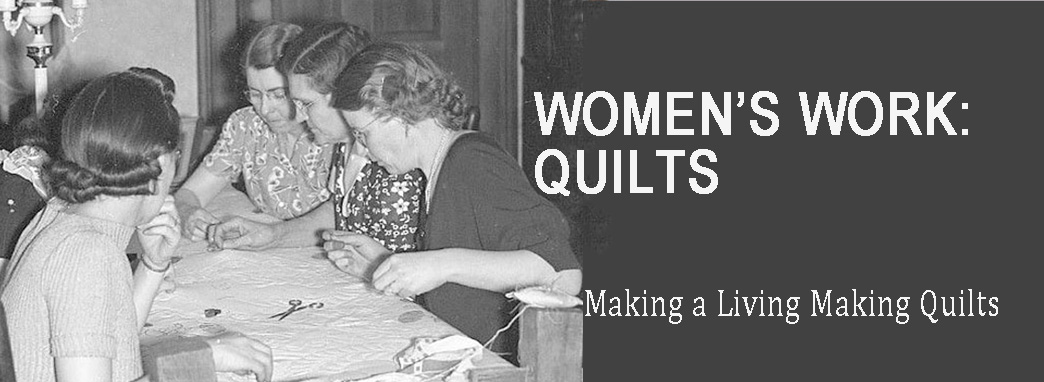Scioto Imhoff Danner (1891-1974)
Pattern collectors are familiar with Scioto Imhoff Danner's quilt booklets. Mrs. Danner's Quilts was a long-lived Kansas pattern source, purchased by Helen Ericson from Danner in the 1960s and only recently closed at Ericson's death.
Scioto (She pronounced it Sigh'-oh-toe) Imhoff was born in Missouri in June, 1891.
ElDorado in 1906
Her parents, half-sister Della and grandmother moved to ElDorado, Kansas at some point. She attended college in Warrensburg, Missouri and taught in Missouri where she kept many ties. During World War I she traveled to Maui to teach in a mission school. Miss Imhoff married Mr. Danner in the 1920s but they soon divorced. Looking for income after her divorce she and the women in her family turned to quilts, hoping they could sell their handiwork. According to her autobiographical manuscript (Blanche Greenstein & Thomas Woodard refer to it in their book Twentieth Century Quilts) selling a quilt for $25 was "like finding an oil well."
Danner made several wedding ring quilts when she
began making quilts to make money. This one, reportedly by her hand, is now
in the collection of the International Quilt Study Center & Museum,
in the Helen Ericson collection.
In the late 1920s she arranged with Wichita's Innes Department Store to exhibit quilts and sample blocks. Few customers were interested in buying her quilts, she later recalled, but "so many people asked me for my designs that I took orders and came home and cut patterns by hand for those who wanted them so badly."
In 1931 Rorabaugh-Wiley's in Hutchinson, Kansas offered quilts for $2
during a Mrs. Danner trunk show in 1931. Wilene Smith found this advertisement.
The manager at Innes's suggested she enlist local high school girls to draft the patterns and mimeograph them. (Let's hope she paid adequately.) This was a low overhead scheme, what we'd
call print on demand. Catalog booklets might be ordered in large quantities but one could mimeograph patterns as they were sold.
Before the Xerox machine every school relied on the mimeograph,
which used a paper stencil wrapped around a drum to print in in sometimes smelly fashion
depending on the technology.
As many other entrepreneurs figured out, selling patterns was the way to profit. Mrs. Danner seems to have been a remarkable success.
In 1934 she displayed her wares at
Kahn's Department Store in Washington, DC.
[Scioto is hard to spell and hard to pronounce.]
Her business model was impressive. She and her employees traveled around the country doing exhibits in department store fabric sections from Macy's at Herald Square to Famous-Barr in St. Louis. The store might show her quilts in the windows and hang some next to the bolts of recommended fabric.
Quilt display (not Danner's) at an Ohio store in 1931
---a popular marketing tool for the drygoods department.
Danner or her employees offered sewing and shopping advice and sold patterns.
In 1934 she began publishing small catalogs of
her popular designs with information about
quilts that inspired the patterns.
At one point she had six (or eight) women traveling for her, each with a set of quilts, blocks, kits, basted tops and patterns. In 1934 she told the Kansas City Star 24 women sewed for her. Thirty plus employees (who took care of the mail?) during the Great Depression is an achievement.
The Ladies' Dream was one of her most popular designs.
See a post on the pattern here:
In 1936 Danner apparently sold most of her 125 quilt samples and moved to Berkeley, California, where she managed a boarding house. Her retirement was not complete, however. A 1938 issue (only issue?) of a Lockport Batting publication Land O’ Nod, the Monthly Magazine for Quilters carried her name as editor.
After her father died in 1942 Danner returned to ElDorado to help her mother and revived Mrs. Danner's Quilts by offering mail order patterns again and republishing her catalogs.
Detail of a Horn of Plenty sampler in Ericson's collection.
According to her obituary (not always accurate) she operated the Cape Cod Flower Shop there too. When she retired in 1970 she sold the quilt business to Helen Ericson who moved it to her home town of Emporia where she designed her own quilts, patterns and catalogs as well as continuing some Mrs. Danner favorites.
How many kits, basted tops and completed quilts did the Danner quilt empire sell in the halcyon days of the 1927-1937 quilt craze? Well, we dropped the ball on this one and forgot to interview anyone in ElDorado during the Kansas Quilt Project in 1986. It never occurred to us that any of those 1930s quilts people brought in to show us might have been made in a complex cottage industry system.
IQSCM has a page on Cottage Industries discussing this little considered topic in their World Quilts.
"Quilts made within cottage industries may be the true anonymous works, particularly because multiple quiltmakers often contributed to distinct aspects of the project—such as cutting, piecing, marking, quilting, or binding—and the final product was removed from its community of creation."
Read Wilene Smith's page on Scioto Danner:
























